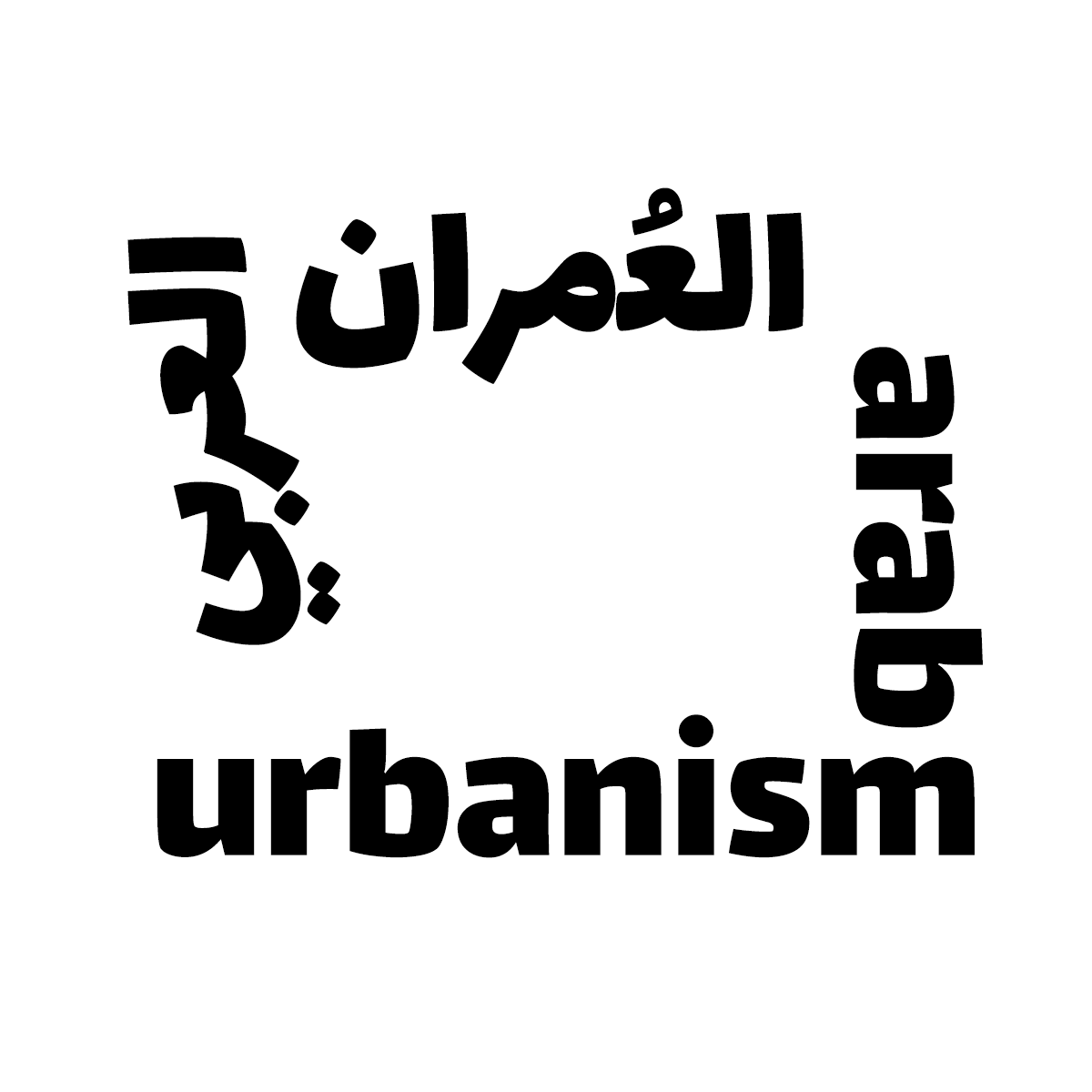“Your Decision and Ours”: Palestinian Strikes in Lebanon & Contemporary Urban Rights
Moné Makkawi
Honking, yelling, chanting, and a river of scooters interrupt seaside dining the evening of July 17, 2019 in Tyre, Lebanon. Hundreds of men carrying Palestinian flags and riding two-to-a-scooter envelop cars on the street and stopping traffic, provoking looks from diners and those strolling along the corniche. It is the evening of the first Juma‘t al Ghadb ([Fri]Day of Rage) 1 protests since Palestinian strikes against the Ministry of Labor (MoL) began on July 11, and the swarm of mopeds, coupled with energetic shouting, make it impossible to look away.
This, of course, is the point. Since the Lebanese MoL’s decision to crack down on foreign workers without special permits in early July, Palestinians have responded with public protests and marches within and outside of the camps, combined with a general strike of Palestinian labor. They have taken these actions to draw sustained attention to the discriminatory nature of the most recent wave of labor laws in Lebanon. While Minister of Labor Camille Abousleiman claims that the new laws do not intentionally target Palestinians, refugees argue that the laws disproportionately impact them as those who, historically, comprise the majority workforce of (exploited) informal markets, and as residents with an unclear, often precarious legal status. Although demonstrations came to a halt after the eruption of the Lebanese Revolution in October, Palestinians had been publicly demonstrating in the streets for over three months, calling for a reversal of the Ministry’s decision and dignified labor laws for all marginalized groups in Lebanon.
Palestinian political movements in Lebanon are not new. From union organizing in the 1950s and anti-imperialist Palestinian Resistance Movements (PRM) in the 60s and 70s, 2 to contemporary strikes against United Nations Relief and Works Agency (UNRWA) funding cuts, 3 Palestinian organizing in Lebanon has represented a spectrum of anti-colonial liberation movements since 1948. But notably, recent labor protests sought to move demonstrations outside of the camps and into the public space of Lebanese cities. As centers of capital accumulation and social interaction, modern cities have become natural sites for political intervention. Though differing in the scope of their aims, movements have largely shared an anti-capitalist sentiment characterized by ideals of collectivity, inclusion, and dignity; in Lebanon specifically, the historical entanglements of colonialism, neoliberal austerity, class stratification, and identitarian division have fueled the emergence of such urban-based mobilizations. 4 Unsurprisingly, Henri Lefebvre’s "Right to the City" essay has seen an analytical resurgence, as scholars, policy makers, and activists attempt to sort through the increasingly urban character of contemporary movements for civil rights. But as such movements and analyses proliferate, new voices and questions emerge locally, complicating our understandings of social movements. While Lefebvre’s "Right to the City" provides a theoretical blueprint for approaching questions of urban justice, it fails to address implications for socio-political change as they are enacted by racialized or stateless actors. In the wake of the recent Palestinian labor protests, it becomes necessary to question how local mobilizations might differ from other urban movements, and further, if they unearth new terrain for grassroots organizing. 5
I argue that the 2019 Palestinian protests and strikes offer an important contribution to a growing oeuvre of transformative urban politics. 6 Against Lebanese attempts at rendering refugeehood and camp life as neatly bound, contained, and invisible, the protests mark an important process of reclaiming public space and elevating Palestinian voices. Further, the demonstrations are significant in that they expose the many paradoxes that espouse (Lebanese) statecraft by highlighting the instrumentality of Palestinian labor in Lebanon. Altogether, the Palestinian protests were innovative mobilizations in that they addressed the immediacy of everyday struggles for dignity and the right to work, while also challenging the exploitative logic of late-stage capitalism and neocolonial dispossession. I suggest that this unifying, accessible movement offered both a counter to local geographies of power, as well as a roadmap for future political organizing.
Sometimes Foreigners, Sometimes Refugees
The Palestinian strikes and protests that erupted on July 11, 2019 should be understood as the most recent manifestation of an enduring fight for civil rights in Lebanon, dating back to Palestinian exilic dispossession after the Nakba in 1948. Some 120,000 Palestinians sought refuge in Lebanon and were settled in UNRWA camps throughout major Lebanese cities like Beirut, Saida and Tyre. 7 8 Refugee labor and capital had an immediate and welcomed impact, as wealthy Palestinians invested in finance, tourism, and engineering sectors, while less affluent Palestinians strengthened agricultural and construction industries as farmers and laborers. 9 10 Newly independent, the Lebanese state enacted measures to police refugees under the pretext of confirming Lebanese sovereignty. Animated by fears that the mostly-Sunni population would destabilize a sectarian balance, early law established a precedent of complex anti-naturalization (colloquially "implantation," or tawteen) laws that were to be consecrated by successive governments. A direct result has been the legal disenfranchisement of Palestinian refugees, who cannot access basic civil rights that are only secured through Lebanese nationality. Since 1948, Lebanese policies of non-integration and discrimination have been insidiously framed as a commitment to the Palestinian right of return, justifying decades of ambiguous legal status, social exclusion, and spatial confinement to refugee camps.
Refugee ostracization was built up over the 1950s and 60s. MoL campaigns in 1951 sought to render employment of Palestinians illegal by prohibiting the employment of Palestinians in large companies or institutions. 11 Soon thereafter in 1964, Presidential Decree No. 17561 saw Palestinians classified as foreigners required to obtain work permits for employment. Curiously, the then-active reciprocity principle of Lebanese labor laws also stipulated that foreigners could not obtain work permits unless their country of origin reciprocated the same benefit to Lebanese workers. 12 These caveats disregarded the realities of Palestinian statelessness and disincentivized pro-Palestinian hiring practices, as employers hired Lebanese nationals to avoid the hassle and expense of permit bureaucracy. Simultaneously, Lebanese authorities implemented population transfers, destroyed informal gatherings, and developed the urban landscape to obstruct or split camps. These were stark reminders of Palestinian transience, intended to engender an atmosphere of insecurity for refugees. 13 14 15
Brief respite came in 1969, when the Cairo Accords – signed by Egypt, Lebanon, and the Palestinian Liberation Organization (PLO) – acknowledged the right to Palestinian existence, movement, and resistance in Lebanon. 16 Crucially, the Cairo Accords guaranteed social and political rights for Palestinian fida’iyin (guerrilla fighters) and granted refugees the right to work. 17 But after the PLO’s expulsion in 1982, Ministerial Decree 1/289 unraveled any progress made by the Cairo Accords, prohibiting Palestinians from working in over 70 commercial, administrative, and professional positions, and relegating Palestinian labor to informal or seasonal markets like construction and agriculture. 18 19 Notably, with the liquidation of the Cairo Accords in 1987, there was no longer any official document from the Lebanese state outlining and securing Palestinian refugee status or rights in Lebanon.
The dissolution of the Cairo Accords was followed by the Ta’if Accords, ending the Lebanese Civil War (1975-1990). Excluded from final status negotiations, the Ta’if Accords emphasized reinstating Lebanese sovereignty, casting Palestinians as a fifth column and principal cause of the war. The post-war climate signaled a discursive shift from recognizing Palestinians as an autonomous political group to depicting refugees as a lawless security threat. 20 Coinciding with Rafiq Hariri’s neoliberal reconstruction, this materialized in renewed commitment to Palestinian segregation. In 1990, the Lebanese constitution was modified to include formal rejection of Palestinian settlement in Lebanon, and in 2001, Palestinians were banned from owning property outside of the camps. 21 In 2005, Memorandum 1/67 lifted restrictions on some professions outlined in 1982, but was still criticized as it did not lift the bans on syndicated professions like medicine, engineering, and law. It also looped Palestinians into an abusive legal apparatus. Palestinians were suddenly required to pay for registered work permits and subscribe to the National Social Security Fund (NSSF), which they could not benefit from as "foreigners." 22 Ratified reforms in 2010 exempted Palestinians from the condition of reciprocity, waived some fees for work permits, and proposed partial social security rights, but were never formally implemented, leaving Palestinian workers unprotected in informal work, taxed on non-existent social-security benefits, and banned from over 39 syndicated professions. 23 24
Together, these measures pushed refugees into the private sphere of informal economies and camps, foreshadowing how Palestinians would continue to navigate dubious labor reforms that play on their intentionally ambiguous status as sometimes-foreigners, sometimes-refugees.
More Legal Gray
The most recent set of labor laws resume a sequence in which Palestinian legal status and rights fluctuate depending on the political or administerial milieu. In early June of 2019, Minister of Labor Abousleiman announced a one-month deadline for business owners to obtain work permits for "illegal" foreign nationals, including those with refugee status. 25 While the Ministry claims an intention to target illegal Syrian work, 26 the new laws extend to Palestinian workers, as the two unprotected communities are often forced to compete for the little work available to foreigners and refugees. Minister of Labor Abousleiman claimed the reforms were, "aimed at protecting [Palestinians] and ensuring their rights," issuing a series of tweets that praised the objectivity of law and vowed to facilitate granting work permits to Palestinian refugees. 27 28 29 Abousleiman’s promises rang hollow when, after the deadline passed, MoL officials issued hundreds of warnings and citations, 30 made arrests, 31 shuttered refugee-owned shops, 32 and dismissed Palestinian laborers from places of work outside the camps. 33 Immediately after workers were fired and the first shops were closed, Palestinians began demonstrations within and around the camps, burning tires at entrances and hosting public sit-ins. [Figure 1]
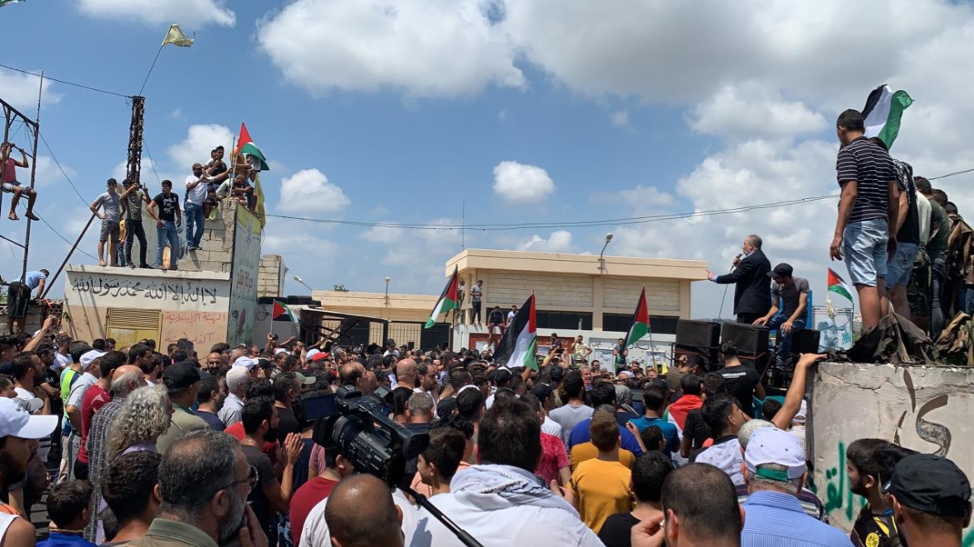
These were shortly followed by more coordinated efforts, where camp community leaders launched a general strike with a set of demands. The motion to strike circulated over WhatsApp and social media, calling for internal action: synchronized shutdowns of Palestinian shops, a cease in Palestinian movement across camp borders, a halt on foreign business in the camps, and limiting the purchase of goods like meat, sugar, and vegetables to camp vendors. Further, the strike asked Palestinians to withdraw all money from Lebanese banks, to forego Lebanese tourist parks, and for diaspora Palestinians to postpone vacations in Lebanon. 34 35 The unequivocal objective of the strikes was to foreground the economic contribution of Palestinians in Lebanon, as well as demand the rights and dignity of Palestinian workers. 36
Palestinians rightly declared the targeting of refugee workers and business-owners part of a larger cycle of prejudiced and contradictory laws that govern labor specifically, and civil rights generally. Indeed, the recent labor laws intentionally failed to account for the specificities of Palestinian refugees in Lebanon, who do not have the legal foreign status granted to economic migrants upon arrival. 37 Further, inherited refugee status is not compatible with current requirements to obtain workers permits, a process that entails money and residency documents that the majority of Palestinians do not have. 38 Lacking clear legal status, denied civil rights, and increasingly dependent on a progressively defunct UNRWA, the newest labor laws mark an attack on the last remaining markets available to refugee workers, deliberately and effectively incapacitating Palestinian autonomy under the guise of reform.
In weaponizing legal ambiguity, the new requirement of foreign work visas should be seen as a local attempt to diminish Palestinian refugee status to that of "foreigner" within the broader context of attempts to undermine Palestinian refugees as a discernible group with irrefutable rights. This is remarkably blatant given rolling cuts to UNRWA services, Donald Trump’s chauvinistic "Deal of the Century," and the xenophobic, racialized scapegoating of refugees in Lebanon. 39 40 Of course, other groups negotiate similar attacks from Lebanon’s debase crony leadership but sometimes lack the capacity to resist. Migrant workers are held captive by the Kafala system, 41 and the targeting of "illegal" work comes amid broader crackdowns on (illegal deportations of) Syrian refugees. 42 Unpacking the 2019 strikes thus stands to benefit from analysis alongside other contemporary movements that champion the rights and dignity of marginalized communities.
What Right, and in Whose City?
Henri Lefebvre’s seminal essay "Right to the City" has enjoyed a resurgence in application over recent decades, as scholars and activists alike are thinking more about connections between cities, neoliberalism, and resistance. In the essay, Lefebvre called on citizens to rally against detachment and segregation to reclaim the planning, capital flows, signification, and social relations that constitute city spaces. 43 Lefebvre established that urban space cannot be reduced to an amalgamation of value, commerce, and profit. 44 Rather, the city is a living text of simultaneity and encounter, the characteristic import being its function as social centrality: "to exclude the urban from groups, classes, individuals, is also to exclude them from civilization, if not from society itself." 45 The right to the city thus indicates a demand for inclusion in the "urban reality" where the terms of socio-political life are decided. Accordingly, the urban becomes both stage and tool for enacting a dignified life.
David Harvey elaborates on the stakes involved in shaping urban space, unpacking how the phenomenon of class is tied to the processes of urbanization: the (re)production of capitalism requires both the exploitation of poor communities for surplus value, as well as urban sites for the absorption of that surplus. 46 The result is a dialogic relationship between urbanization and inequity, with successive degrees of dispossession. Clearly, because cities are pivotal sites for the accumulation of capital and social relations, they are also exemplary spaces in which access, inclusion, and sociality unfold over and actively generate a hierarchized urban landscape. Urban space is therefore central to the (re)production of forces that organize society. As Mona Fawaz notes, this is particularly salient in Lebanon, where sectarianism is tethered to class, and informs the logic of spatial organization through clientelistic demarcations of administrative and voting jurisdictions. 47 48 Urban space is perhaps even more significant for refugees, who comprise a sizeable chunk of the Lebanese workforce. Accordingly, the goal of fashioning a just city hinges on the working class, whose labor serves as the scaffolding for surplus value and capital flow.
Contrary to hegemonic discourse, and despite spatial, legal, or social restrictions on refugee work and movement, Palestinian refugees do make up a fundamental and irreplaceable part of that working class. Though the majority of Palestinians live in camps policed by Lebanese security forces – sometimes completely walled off to isolate refugees – the camps are increasingly integrated into the urban fabric of Lebanese towns and cities. 49 Everyday refugee mobilities often involve crossing camp boundaries, yet Palestinians are still branded as outsiders or existential threats to Lebanese sovereignty and resources. Notwithstanding the baseless accusations levied against refugees by bureaucrats and nationalists, it remains clear that the Lebanese economy depends on and profits from Palestinian labor.
Generally markets that Lebanese are unwilling to engage in, Palestinians have had a significant impact on Lebanon’s agriculture and construction sectors as a ready pool of cheap labor since 1948. 50 51 Today, though reluctantly marshalled into seasonal, insecure, and dangerous labor, 52 Palestinians continue to contribute to the growth of Lebanon’s GDP. Small Palestinian businesses inside and on the fringes of camps and gatherings are considered the mainstay for economic growth in Lebanon. 53 Well-integrated camp communities and their low-cost markets, like Ein al Helwa and (previously) Nahr al Bared markets, invigorate surrounding areas as major, informal economic centers for poor Lebanese and Palestinian communities. 54 55 Unlike other non-Lebanese workers, Palestinian refugees consume and save inside Lebanon, comprising a long-term labor pool that has helped build multiple service industries over decades. 56 An estimation of over $60 million (US) in remittances from Palestinian migrant workers flow into Lebanon annually. 57 58 All in all, surveys estimate that Palestinian refugees in Lebanon contribute more than $300 million (US) a year to the Lebanese economy. 59 Clearly, Palestinians profoundly transform, determine, and sustain the urban environments that host them, regardless of segregation and marginalization. 60 61 It follows that the Lebanese state’s negotiation of Palestinian labor thereby reveals itself as paradoxical: it is both an indisputable dependence on Palestinian labor outside the parameters of the camps, and a doggedly punitive refusal to formalize Palestinian roles in the Lebanese urban polity.
With or without the sanction of Lebanese law, the 2019 protests and strikes signal a decision to recover the socio-economic forces that Palestinians shape and are shaped by. Centering Palestinian "shaping power" reveals how Palestinian labor is indispensable in refashioning a defunct economic system and discordant urban landscape. 62 More than that though, the strikes emphasize that fair labor practices are what Palestinians are owed as enduring and begrudging architects of capitalist accumulation in Lebanon. The initial impact of the strike’s first week exposed the depth of Lebanon’s dependence, when pictures of an empty Saida market filled with untouched produce circulated over social media and WhatsApp. 63 In one video, a young man is shown throwing rotting eggplants into the back of the truck, as the man recording says, "Look (respected) Minister (of Labour), at your decision… and (us with) ours." That the strikes took a fiscal toll is also suggested by the reaction from MoL Abousleiman, who took to twitter to rebuke their impact. 64
The appeal and significance of the protests is also evidenced by protest slogans "karama wa bas" (Just Dignity) and "bkafi" (Enough), which frame discussions of workers’ rights under capitalism in an accessible, refugee-specific way. Circulated media, official statements, and protest banners were usually stamped with either phrase. Succinct and commanding, the campaign pointed to a political impasse and situated the protests within a wider arch of urban rights-based movements without the limitations that sometimes accompany political mobilizations. For example, grassroots movements in Lebanon like "You Stink" or Beirut Madinati (Beirut is My City) also foreground dignity and collectivity, challenging government corruption and housing inequity in terms of an urban "membership" unencumbered by legal status or nationality. But they perhaps leave something to be desired by way of accounting for refugee and migrant communities, who navigate urban belonging, state violence, and the texture of capitalism in completely different ways. This of course does not discount the crucial work of such movements and is not meant to imply a hierarchy of values in organizing; rather, the point is that there exists a small gap in leftist organizing. A shift towards accounting for the complexities of refugeehood expands the toolkit for claims-making and enables a comprehensive and interconnected counter to the Lebanese oligarchy or dispossessive neoliberalism.
Because the city is central to the logic of neoliberal capital, reclaiming the social value of city spaces is undeniably linked to the articulation of a dignified life. 65 And while proving the economic worth of vulnerable peoples should be superfluous for granting civil rights, it remains an important point to make. If we can see how Palestinians comprise an irreplaceable part of the Lebanese workforce, and how Palestinian labor sustains the socio-economic forces that shape cities all over Lebanon, we can also understand how withholding labor power and moving demonstrations into the Lebanese public calls out a type of indebtedness. The Lebanese government, like other neocolonial states, has sought to exclude Palestinians from social space and legal protection, opting instead to exploit Palestinian labor while criminalizing Palestinian existence. But just as Palestinians recognize how they spackle an inept economy, they also identify its causal origin in a despotic ruling class. Centering an ontology of dignity thus becomes a pursuit for renewed collective life outside predetermined capitalist geographies. Protestors and statements made this intention clear by framing the movement in terms of self-determination, rather than a simplistic anti-Lebanese animosity. 66 The gravity of this approach is surely reflected in instances when Lebanese citizens joined public demonstrations. 67 That the ideal of dignity is partly nebulous creates space for people-based politics and future rights-based collaboration.
Writing (Palestinian) Futures in Lebanon
The intentional ambiguity of Lebanese labor laws overlay historic efforts to anchor Palestinian refugees in marginal work and camp-specific space. Joined with the concretization of Lebanon’s neoliberal reconstruction process after the Civil War, 68 it becomes clear that any mobilization around urban labor rights in Lebanon is also a critique of an atomizing, degrading, and exclusionary economic order. 69 Lebanon’s current politico-economic system is marked by distinct poverty, monopolistic privatization, and clientelism. Oligarchical capital accumulation and consolidation is extreme and realized at the expense of Lebanese, migrant, and refugee communities. 70 The Palestinian strikes were a refugee-led intervention against those material conditions imposed by late-stage capitalism. In centering dignity and visibility, the protests offer insight on questions of class, identity, and the poetics of organizing. [Figure 2]
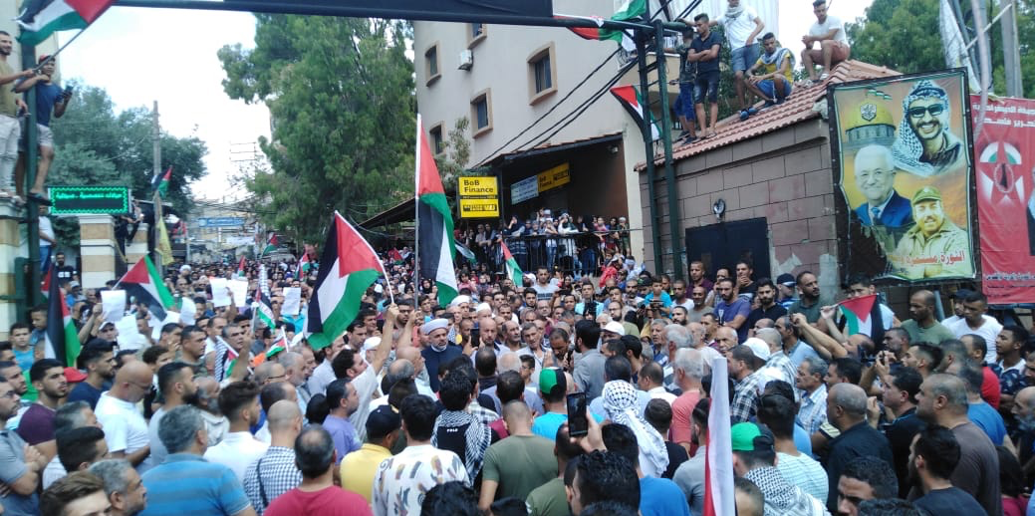
First and foremost, strike and demonstration organizers worked to unify refugees against historic attempts at fracturing Palestinian communities, locally and abroad. In Lebanon, the diffuse topography of camps – coupled with surveillance, checkpoints, and regulated movement via permit systems – has divided Palestinian families and villages. 71 Initially, as a direct response, internal camp space was organized to commemorate Palestinian village life in the commons. 72 Over decades, camp geographies also came to be carved up by various Palestinian political factions and loyalists, camp space serving as the terrain for power-grabs and party control. Largely absent from the strikes though, was central coordination by Palestinian political parties. Though party leaders from various factions played nominal roles in negotiations, 73 74 Palestinian organizers emphasized national unity, decisively framing the protests as secular, socialist, and popular. 75 76 In Ein al Helwa for example, activists reported that the demonstrations helped transgress the unspoken political boundaries between neighborhoods; in multiple camps, collaboration between factions and parties facilitated peaceful marches and buoyed the strike against Lebanese goods. 77
Palestinians also forged new trans-camp networks for organizing and protesting in consensus. Protestors centered yad wahid (one hand, or unified front) as the organizing principle for synchronous actions. 78 Movement Committees were established to, touch-base with camp vendors, discuss strategies for involving women and children, accelerate demonstrations in Lebanese spaces, and uphold the boycott of Lebanese goods, and crucially, to coordinate with other camps. 79 Movement leaders launched initiatives to support the strikes in other camps. For example, vegetables, crops, and money donations were collected from Rashidieh, Shatila, and northern camps and sent to Ein al Helwa camp in Saida. 80 Importantly, these new networks undermined estrangement between Palestinian communities as independent, self-sustaining, and locally-led initiatives; goods grown in-camp were delivered directly to other refugees without Lebanese mediation. [Figure 3]
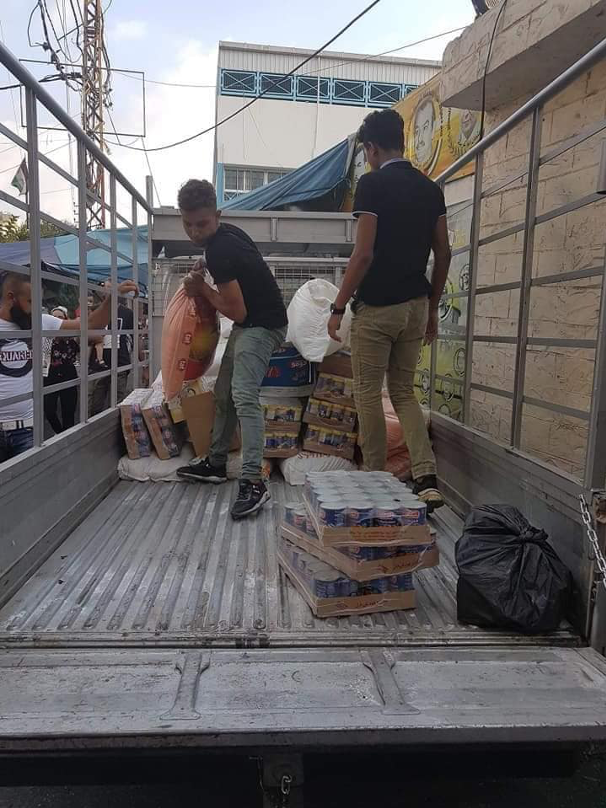
Abroad, Palestinians and allies alike demonstrated in solidarity with protestors in Lebanon, employing social media to build attention on the strikes despite negligent media coverage. Throughout July and August, Palestinian and Arab-led organizations like the Palestinian Youth Movement (PYM), Within Our Lifetime (WOL), and Samidoun (among others) organized US actions, while protests were also held in Copenhagen, Sweden, Amsterdam, London, Australia, Greece, Berlin, and the Occupied Palestinian Territories. 81 In Gaza, alongside ongoing Great March of Return protests against Israeli occupation, young men and women raised signs declaring support for the strikes in Lebanon. 82 Subsequently, these demonstrations and campaigns functioned to renew networks of support and reestablish severed lines of communication. Collaboration between Palestinians stands in direct opposition to the caesura imposed by settler colonialism and exile. More importantly, these actions linked local demands made in Lebanon to the global stage. Social media campaigns commissioned the hashtag #StarvingMeServesTheDeal, connecting the MoL policies with Trump’s "Deal of the Century." This amplified refugees’ widely-held belief that the recent laws imply acquiescence under American-Israeli pressures to undermine the Palestinian right of return. 83 84 Highlighting the shared neocolonial vision of states like the U.S. and Israel is an invaluable tool in understanding the present-day scope of obstacles facing (Palestinian) liberation, and the stakes involved in growing solidarity. [Figure 4]
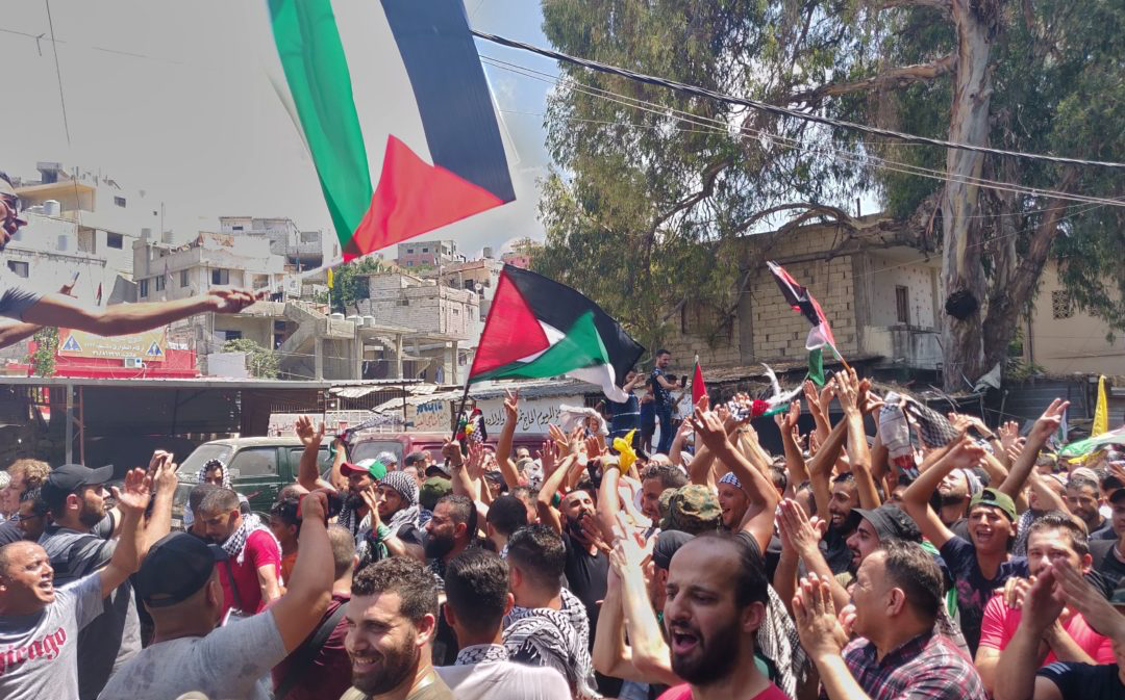
Concurrently, as demonstrations progressively moved into the Lebanese public sphere, they became undeniable reminders of a disregarded Palestinian community. Embodying a "disruptive potential" for emancipation from market and state rules, 85 the demonstrations employed unruly strategies and actions. Against the pragmatism of routine, Palestinian strikes, protests, and demonstrations were vibrant confrontations, interruptions that perforated and disintegrated the stasis of everyday urban landscapes. Some methods were subversive in their tact, upsetting the assumed equilibrium of socio-economic space. For example, one campaign that coincided with the beginning of the strikes saw protestors stamping Lebanese currency with blue Palestinian flags and the word "Palestine," even encouraging Lebanese to join in solidarity. 86 87 88 [Figure 5] The pictures of marked bills circulated on social media, prompting frenzied questions about the devaluation of the lira and forcing politicians to address fears of counterfeit currency. 89 Another campaign called on Palestinians to forego turning on or adding data to their phones for a full day. 90
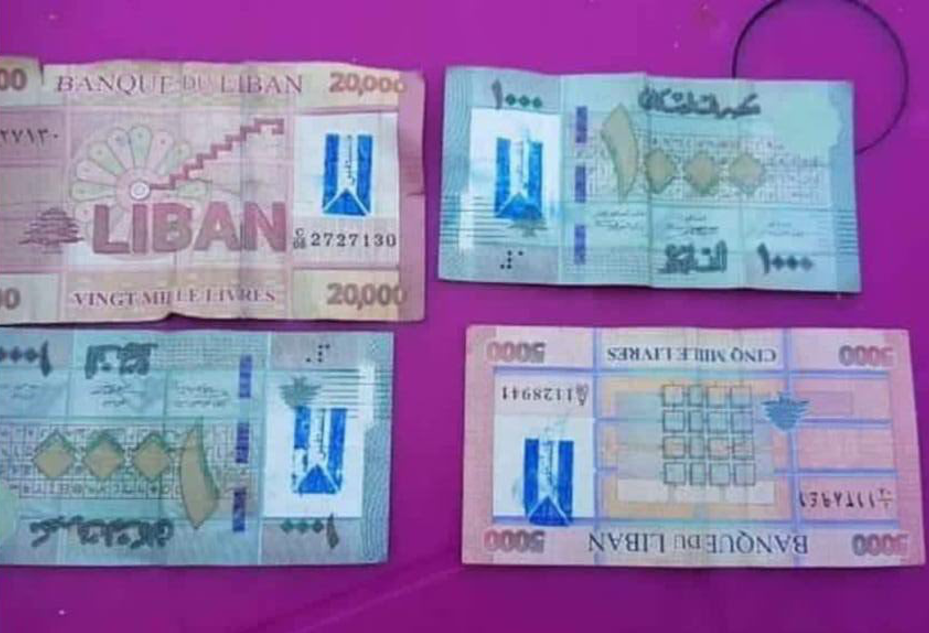
Other approaches were more direct, brazenly asserting Palestinian demands and identity on Lebanese streets. For example, in Beirut, the Palestinian Right to Work Campaign Coalition organized a protest in front of the House of Parliament; another day, thousands of Palestinians, and Lebanese allies, marched to the MoL headquarters with raised Palestinian flags, congregating in front to deliver speeches against the new laws. 91 In the southern city of Saida, protestors dropped a massive Palestinian flag over the famed crusader Sea Castle, 92 car marches were coordinated to disturb traffic, and a hashtag campaign #RaiseYourFlagProveYourExistence called on Palestinian residents to raise flags on the balconies of their homes and shops to claim visibility. 93 From my apartment bordering Burj al Shamali camp in Tyre last summer, I heard how the athan (call to prayer) was soon followed by a newfound soundscape of chanting, cheering, singing, and even pop music. Traditional drums, music from Palestinian artists like Mohammed Assaf, chants led over megaphones, and billows of smoke from burning tires all surpassed the boundaries of camps to impress themselves upon neighboring communities. In downtown Tyre, the leisure of summer evenings alongside the Mediterranean was sporadically punctured with cavalries of Palestinian scooter riders by the hundreds, shouting protest chants and waving Palestinian flags. Public marches broke out into pockets of dabke (a Palestinian dance) and scooter crews swarmed cars, stopping traffic en masse with drivers honking in either approval or annoyance [Figure 6]. Altogether, the mosaicism of refugee tactics called attention to the force of Palestinian labor by decalcifying the layers of separation between (supposed) Lebanese and Palestinian spaces.
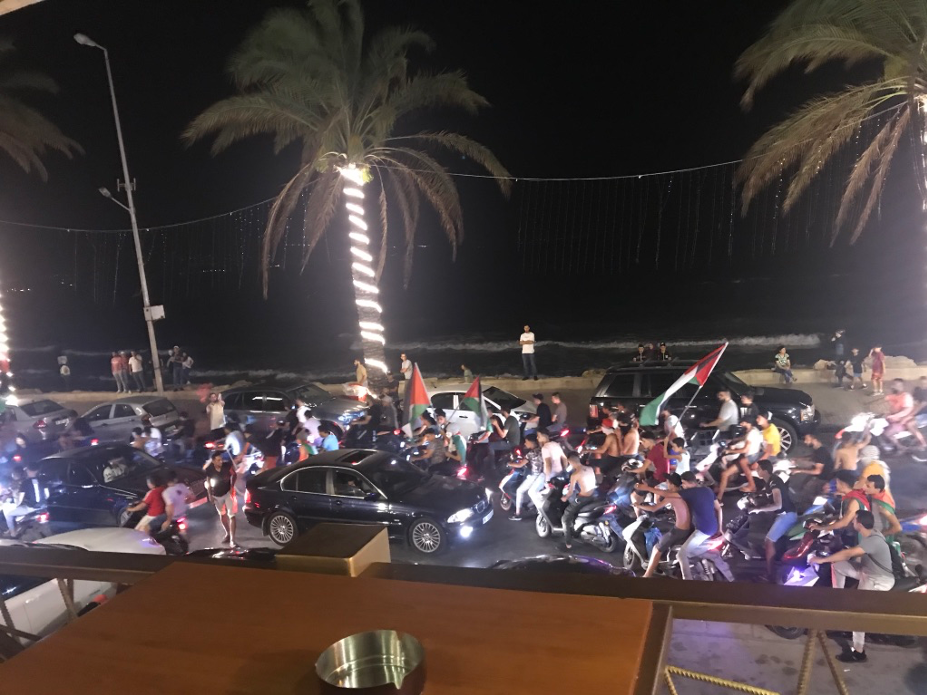
Importantly, these were also moments saturated with the elation of carving out a space for collective Palestinian identity. The effervescent space of metropole, periphery, and the entire spectrum between, all became important ‘centers’ of social access for Palestinians who have been denied public expression and existence in Lebanon. In laying claim to the city, these disruptions were collective practices of conviviality that carried the potential to upend isolation; they were united displays of "jouissance" that marked a break in state-ordained repression and erasure; they signal a capacity to salvage the decisive terms of livelihood from capitalist geographies of control, consumption, and individuation. 94 As Laleh Khalili notes, we do not need to reduce these acts to narrow definitions of resistance to understand them as meaningful; rather, such mobilizations are important, precisely because they are public and collective, in that they mark a social transformation. 95 These moments were celebrations of an alternative futurity. [Figure 7]
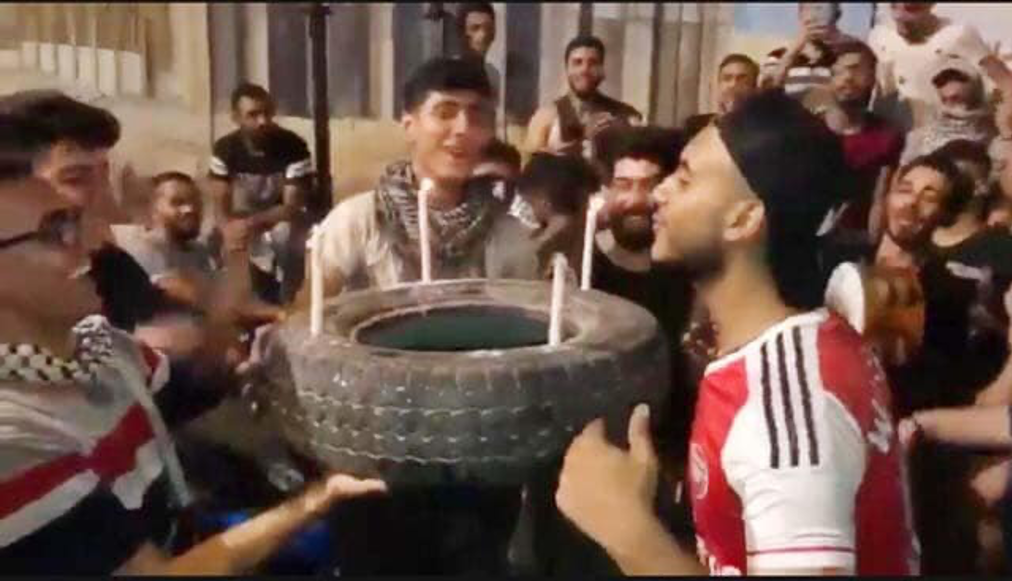
Of course, flooding the public with Palestinian elation renders the demonstrations ideologically dangerous by calling attention to the polemics of class struggle in Lebanon. It is no surprise that as marches, demonstrations, and protests were organized throughout Lebanon, they were met by xenophobic, sensationalized media coverage, hostility, and violence. Accusations that Hamas was behind the protests, evocations of the Lebanese Civil War, and racist insinuations of an innate Palestinian barbarism were all tossed around Lebanese media outlets. 96 97 Simultaneously, in the streets, peaceful protesters were met with brutality. On July 16 for example, public demonstrations outside Ein al Helwa camp in Saida were broken up by Lebanese Security Forces. A video on twitter shows Lebanese soldiers arriving by truck, swarming isolated protestors, and beating them. 98 Protestors even reported seeing friends and activists stuffed into cars by Lebanese mukhabarat (secret police). 99 Together, these intransigent reactions meant to mitigate potential solidarity and weaken the legitimacy of Palestinian demands. For the divide-and-conquer schemes of Lebanese despots, a resurgent and refugee-led politics looms as existential threat. New connections between camps – or between host and refugee communities – gradually excavate shared legacies of class coevality, anti-occupation resistance, and anti-imperial politics. That these tensions exist beyond an ideological battleground is evidenced in part by the onset of the Lebanese uprisings.
Reprise in Revolution
Despite clear attempts to extinguish the protests, Palestinians demonstrated for over three months, overlapping with the start of the Lebanese Revolution on October 17, 2019. Entering a fourth month, the country-wide protests have called for the resignation of the Lebanese government, economic reform, and new electoral laws after decades of government corruption, neoliberal austerity, and political sectarianism. Though eclipsing strike demands, Palestinian refugees supported the budding Revolution while carrying out their own demonstrations, continuing even after the Palestinian protests were put on hold. 100 That Palestinian demands stressed class solidarity and coalition building is evidenced in how refugees continue to show up for Lebanese demonstrations, insisting that supporting the Revolution is an imperative of terms of solidarity and practicality. 101 102 Palestinians know all too well the stakes involved in establishing a new Lebanese government and have seized an opportunity to help dictate the terms of its formation. In this sense, though sidelining refugee demands, Palestinian participation in the Lebanese Revolution should be seen as an extension of the 2019 labor protests.
It follows that we could then see how recent Palestinian demands reverberate throughout the political shifts and social discourse of the Revolution, and why that matters. The Lebanese uprising has cast a harsh light on the neocolonial metasystem of Lebanon’s sectarian regime, 103 and like the Palestinian labor protests, mobilization has unfolded less along traditional party lines and increasingly around class solidarity, national unity, and urban rights. This is obvious in protestors’ tactics of reclaiming privatized beaches and abandoned buildings, but also finds resonance in street discourse. Protestors have spray-painted pro-Palestinian graffiti on public walls, shamed racist, xenophobic politicians in chants like "laja’een juwa juwa, Bassil bara bara" ("refugees in, [Gibran] Bassil out"), and raised Palestinian flags alongside Lebanese ones. 104 [Figures 8 and 9] The most stirring display though, came when protestors in Beirut chanted, "falasteen nahna mak hata lmuut, wa ein al helwa nahna mak hata lmuut, wa bourj al shamali nahna mak hata lmuut" (Palestine we’re with you until death; Ein al Helwa [camp] we’re with you until death; Bourj al Shamali [camp] we’re with you until death). 105 Protestors’ initiatives to uplift pro-Palestinian discourse signal extraordinary and important – but admittedly incremental – redactions of Lebanese discrimination. These brief and lucid revelations under the fever-dream of uncertain Revolution mark an understanding of how refugees are mutually imbricated in many of the social, political, and economic forces that impact Lebanese citizens. This is where solidarity gains traction and depth, and this is how social shifts become absolutely transformative.
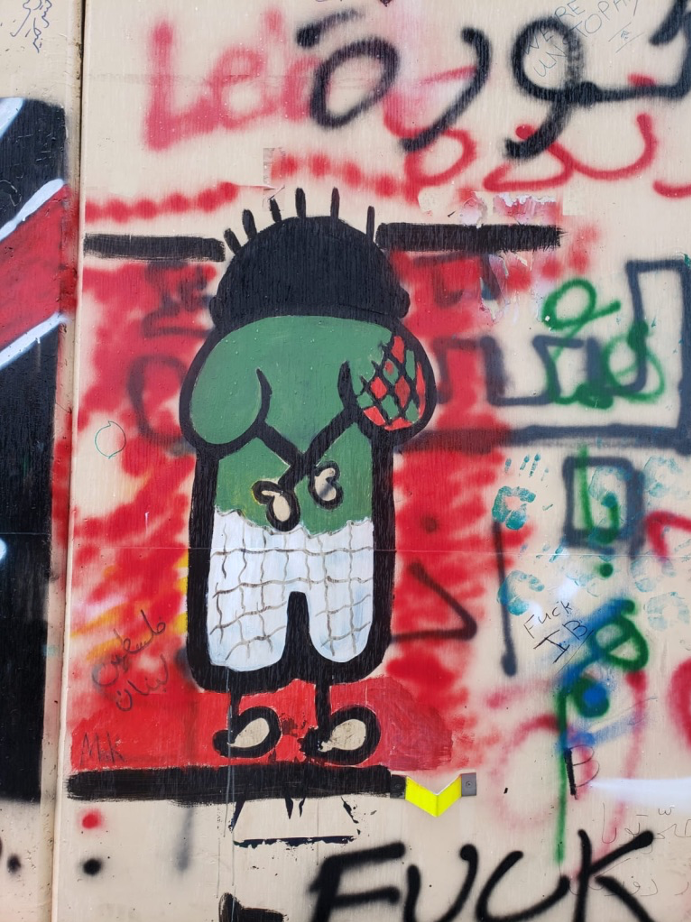
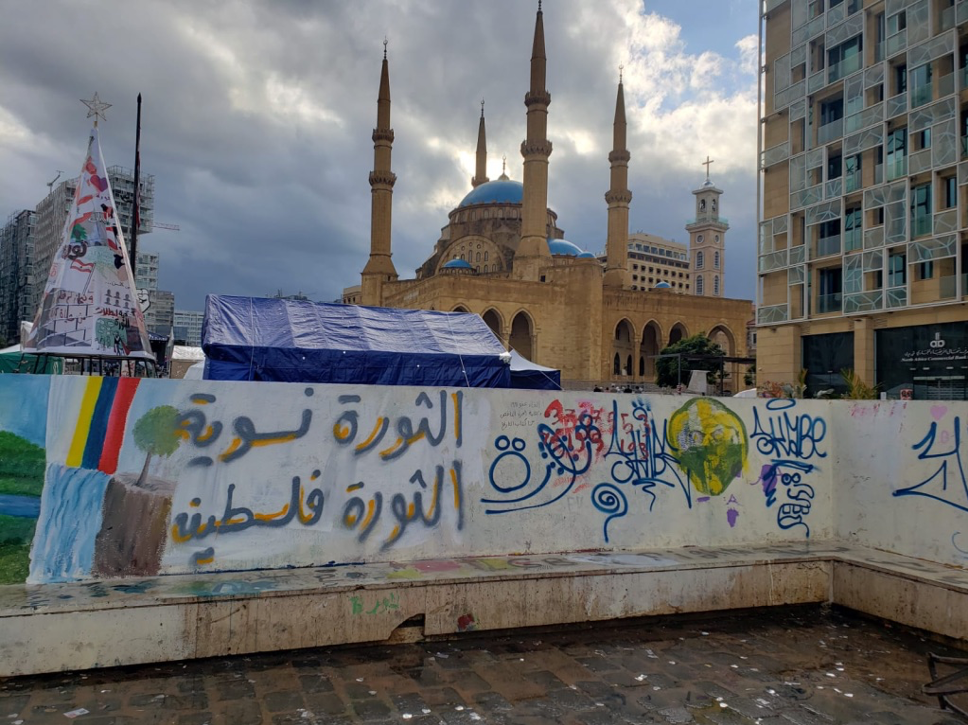
"bdna na‘ish bkarama" (We Want to Live with Dignity)
From the initial rupture of Zionist settler colonialism in Palestine to the recent labor protests, Palestinian refugeehood has indelibly marked the Lebanese urban polity. In response, the Lebanese government has weaponized refugee statelessness, withholding civil rights under the pretext of supporting the Palestinian Right of Return. Buttressed by systematic restrictions on labor rights, decades of exclusionary policies reveal a Lebanese ruling class bent on Palestinian communities that are subdued, reduced to scale, and relegated to the camps. 106 The recent MoL labor curb is but one of many historic attempts to smother Palestinian autonomy.
The Palestinian labor protests that began July 11, 2019 succeeded in carving out a public space of Palestinian demands for workers’ rights, dignity, and being. That the demonstrations were effective, even briefly, is reflected in that they linked up with transnational movements, shifted social discourse, and disrupted alienation from the Lebanese public sphere. That the demonstrations were particularly threatening is obvious given the reactionary rhetoric of the Lebanese media, attempts at censorship, and violent crackdowns.
Using the city as both stage and substance for political claims, 107 the protests called out the hypocrisy of a Lebanese ruling class that leverages the murkiness of Palestinian legal status as it commodifies Palestinian labor. Even worse, the sometimes-label of "foreigner" facilitates Palestinian deprivation, stripping refugees of their legal rights (to work, to education, to citizenship) while masking the colonial circumstances of their dispossession. The strikes, therefore, are both a declaration of Palestinians’ instrumental labor power and an avowal of unity against erasure. The strikes and demonstrations point out the city’s centrality in contemporary struggles for justice by demystifying how power, ideology, and economic disparity are coded into and unfold over urban space. Privileging this type of advocacy offers an accessible politics that might forge new pathways for future collaboration and mobilization. Significantly, the protests remind us that there exists potential for refashioning the city through an architecture of collectivity and conviviality as opposed to consumption. 108
Though the demonstrations and strikes have been put on hold, the 2019 labor protests remain an important iteration of Palestinian coalition building in Lebanon. As they dovetail with the ongoing Lebanese Revolution – or uprisings in Gaza, Haiti, Chile, Iraq, etc. – the protests are situated within and contribute to a vibrant geography of anticolonial and anticapitalist movements. As such, we cannot understand current geographies of power in Lebanon without discussing Palestinian refugees; likewise, we cannot discuss Palestinian refugeehood without centering the legacies of colonialism or advocating for the Right of Return. Though challenges remain, the 2019 protests move us forward. Those who live in the master’s house know intimately the web of forces that define the material conditions of their daily lives. 109 At the crossroads of inequity and injustice, Palestinians know best the necessity to reclaim and reshape such forces. This is why Palestinians in Lebanon are paving the way to liberation: quite simply because they are the most equipped to do so.
Author
Moné Makkawi is a third-year PhD student at NYU’s department of Middle Eastern and Islamic Studies. Her past work has focused on water infrastructure networks, access, and distribution within the Palestinian refugee camps in southern Lebanon. Her current research continues to center the nexus of Palestinian refugeehood and material landscapes, focusing specifically on the intersections of space, infrastructure, critical culture, political economy, and Palestinian refugee urban identity in the contemporary city. She is committed to Palestinian self-determination and solidarity work.
-
Major actions were held every Friday. Though in Arabic they were literally called “Friday of Rage,” the more appropriate translation is that of “Day of Rage.” ↩
-
Rosemary Sayigh, Palestinians: From Peasants to Revolutionaries. London: Zed books, 1979, 118 ↩
-
Martin Armstrong, “Palestinians Protest Against UNRWA Cuts in Lebanon.” Al Jazeera, February 29, 2016. https://www.aljazeera.com/indepth/features/2016/02/palestinians-protest-unrwa-cuts-lebanon-160223151011960.html. ↩
-
Mona Fawaz, “Beirut Madinati and the Prospects of Urban Citizenship.” The Century Foundation. April 16, 2019. https://tcf.org/content/report/beirut-madinati-prospects-urban-citizenship/?agreed=1&agreed=1. ↩
-
Ibid. ↩
-
This piece will be focusing on Palestinian refugees because of the protests they held in 2019, but it must be noted that the recent changes in labor law targeted Syrian refugees. Syrian refugees are drastically impacted by the MoL changes and are facing an ongoing campaign led by right-wing Lebanese politicians who aim to force Syrian emigration. Though outside the scope of this article, the persecution Syrians currently navigate in Lebanon is deplorable and requires considerable attention. ↩
-
While substantial amounts of Palestinian capital flowed into Lebanon due to the economic boycott of Israel and the newfound primacy of the Beirut port, the Lebanese government wasted little time in declared Palestinian refugees an economic burden and making attempts to deport them back to Gaza and the West Bank, or dump them over the Syrian border. ↩
-
Scholar Rosemary Sayigh has shown that this separation, division, and settlement was largely carried out according to the Lebanese desire for cheap labor in Beirut, as well the logic of sect and class. Middle-class urban Palestinians settled freely in Lebanese cities and saw easy access to work, and travel; poor and rural Palestinians suffered material hardship, economic exploitation, and little-to-no civil rights. Further, the majority of Palestinians were rural, peasant, and Muslim, and were not granted citizenship, while Christian Palestinians were encouraged to take Lebanese citizenship in order to bolster Maronite supremacy in a sect-based political system. This strategic move to secure newly reified ‘sectarian balances’ of power informs contemporary ambiguity in legal status. Then, and still today, the decision is regressively justified by the notion that Palestinian citizenship in Lebanon would undermine the Right of Return. Such an argument is often presented in nationalist anti-tawteen (implantation) discussions in Lebanon, the implementation of which Palestinians have consistently rejected anyways. ↩
-
The Arab High Committee estimated approximately 90 million Lebanese lira (LL) in early capital contributions - Fawwaz Traboulsi, “Al-tabaqat al-Ijtima’iyya fi Lubnan: Ithbaat Wujud.” Heinrich Boll Stiftung, (2014), 42 ↩
-
Fawwaz Ṭraboulsi, A History of Modern Lebanon (London; Pluto, 2007), 113-114 ↩
-
Rosemary Sayigh, Too Many Enemies (London; Atlantic Highlands, N.J., USA: Zed Books, 1994), 23 ↩
-
International Labour Organization (ILO) and Committee for the Employment of Palestinian Refugees in Lebanon (CEP). 2014. Palestinian Employment in Lebanon: Facts and Challenges. Labour Force Survey Among Palestinian Refugees Living in Camps and gatherings in Lebanon. (Beirut, ILO Regional Office for the Arab States and CEP), 21 ↩
-
The Intra Bank crisis further affirmed the precarity of Palestinians in the workforce, when the Lebanese ruling class expedited the crash of Yusuf Baydas’ Intra Bank. Baydas, a wealthy Palestinian entrepreneur, built a finance empire – the Intra group – that had consolidated control of various Lebanese institutions during the 1960s. The Intra group controlled a number of the country’s major companies, ran the strongest bank in Lebanon, financed the government’s infrastructure projects and imports, and played intermediary for the Lebanese financial sector and foreign investments. Under pressure from a traditional oligarchy linked to Western financial capital, the government decided to ‘sink’ the Intra Bank in 1966. After the Intra Bank crisis, immediate fallout included the bankruptcy of local banks, capital flight (18.6 million withdrawn in less than a month), and in-fighting amongst the Lebanese ruling class. Further, without legal safety nets, Palestinian refugees were particularly impacted by the economic crash. Fawwaz Traboulsi, A History of Modern Lebanon (2007), 150. ↩
-
Sayigh, Too Many Enemies, 73 ↩
-
These efforts were compounded by the Lebanese Surete Generale, later known as the Deuxieme Bureau (DB) or maktab al-thani. The Surete Generale policed camp borders and harassed Palestinians. Measures imposed include banning Palestinian political activity, professional work and arms possession, intimidation and extortion, and planting collaborators in Palestinian communities. Sayigh, Too Many Enemies, 68-71 ↩
-
Because prevailing discourse often depicts the Palestinian presence as a “state within a state” that undermines Lebanese sovereignty, or more egregiously, as the lone cause of the Lebanese Civil War, it is important to note that the Palestinian fida’iyin were favorably welcomed by a Lebanese population reeling from defeat after the Six-Day War in 1967. Historian Fawwaz Traboulsi points out that disillusioned Lebanese youth joined the ranks of the fida’iyin, and even hosted demonstrations in support of the PLO after the Lebanese army spent the 1967 war defending foreign embassies and American/British oil company headquarters instead of joining other Arab armies in fighting the Israelis. In addition, the Lebanese government helped establish fida’iyin bases in southern Lebanon, backing out only after Israeli and Syrian pressure forced them to do so. Traboulsi, A History of Modern Lebanon, (2007), 152. Such historical revisionism also ignores how the PLO was vital in providing early social services for Palestinian refugees, inaccurately painting the organization as purely militant. ↩
-
Ṭraboulsi, A History of Modern Lebanon. 154 ↩
-
The MoL added another 46 high-status jobs to this ban in 1995. ↩
-
ILO and CEP, “Palestinian Employment in Lebanon,” 23 ↩
-
Post-war politicians strategically framed the Lebanese Civil War as one of “outsiders” and of “others.” Invoking threats of sectarian or foreign violence shifted blame to refugees, protected class interests, and effaced the role Lebanese elites played in bringing the country to turmoil. Traboulsi, “al-tabaqat,” 25 ↩
-
Though dubbed “foreigners” in various labor laws, Palestinians remain denied the right to own property in Lebanon, a privilege granted to other foreign migrants. The ban on Palestinians registering legal title to housing and real estate, or inheriting land (Presidential Decree of 11614, modified by Decree 296 in 2001) is based on a lack of “citizenship issued by a recognized state.” Both stateless and denied citizenship in Lebanon, this law effectively eliminates any opportunity to live with stability outside of the refugee camps. ↩
-
ILO and CEP, “Palestinian Employment in Lebanon,” 23 ↩
-
Ibid., 24 ↩
-
The lack of work opportunities for Palestinians often forces refugees to undertake dangerous work. For example, after the 2006 Hezbollah-Israel war, Palestinians worked throughout farmlands in southern Lebanon to clear unexploded cluster munitions for $5 (US) per bomb cluster. These Palestinians weren’t part of the official clearance program and had no formal training or protective gear. (Rebecca Roberts, Palestinians in Lebanon, 2010), 107 ↩
-
Amena ElAshkar, “Palestinian Refugees in Lebanon denounce new ‘inhumane’ work restrictions.” Middle East Eye. July 23, 2019. https://www.middleeasteye.net/news/palestinian-refugees-lebanon-denounce-latest-work-restrictions. ↩
-
Camille Abusleiman, (@camilleasleiman),للمرة الاولى تنطلق حملة لمكافحة العمالة غير الشرعية, Twitter, July 11, 2019, https://twitter.com/camilleasleiman/status/1149217610774523904 ↩
-
https://www.middleeastmonitor.com/20190720-lebanon-general-strike-sweeps-palestinian-camps-for-5th-day/ ↩
-
Camille Abusleiman, (@camilleasleiman), تلقى اتصالا من نظيره الفلسطيني ويؤكد تقديم التسهيلات لحصول الفلسطينيين على اجازات عمل, Twitter, July 17, 2019, https://twitter.com/camilleasleiman/status/1151451836769034240 ↩
-
Camille Abusleiman, (@camilleasleiman), جاهزون لتقديم كل التسهيلات لحصول العمال الفلسطينيين على إجازات عمل, Twitter, July 18, 2019, https://twitter.com/camilleasleiman/status/1151937432679587840?s=12 ↩
-
Lama Al-Arian, “In Lebanon, Palestinians Protest New Employment Restrictions.” NPR. July 26, 2019. https://www.npr.org/2019/07/26/745041157/in-lebanon-palestinians-protest-new-employment-restrictions ↩
-
National Information Agency. “The Outcome of the Ministry of Labor Inspection.” Annahar. July 25, 2019. https://www.annahar.com/article/amp/1001724/حصيلة-تفتيش-وزارة-العمل-3-إقفالات-و93-ضبطا-و30-إنذارا. ↩
-
Reports indicate that 34 businesses were closed by the end of July. Julia Kassem. “Lebanon’s labor minister vows to continue crackdown despite wave of protests.” Mondoweiss. August 20, 2019. https://mondoweiss.net/2019/08/lebanons-minister-crackdown/. ↩
-
Marie Kortam, “Lebanon: Anger in Palestinian Refugee Camps Gives Rise to a New Mobilization for Dignity.” Arab Reform Initiative. August 14, 2019. https://www.arab-reform.net/publication/lebanon-anger-in-palestinian-refugee-camps-gives-rise-to-a-new-movement-for-dignity/. ↩
-
WhatsApp circulation, July 2019. ↩
-
Importantly, the call to revoke the MoL’s decision was also followed by demands for legal housing, removing the ban on syndicated professions, and full social security benefits under the NSSF. Marie Kortam, “Lebanon: Anger in Palestinian Refugee Camps Gives Rise to a New Mobilization for Dignity.” ↩
-
On this point specifically, Palestinian discourse has been both intentionally clear and general. Beyond the specific demand to overturn the 2019 labor laws, protestors have decried the general state of workers’ conditions in Lebanon, demanding systemic reform. These demands were articulated so that they might apply to other marginalized populations in Lebanon like working-class Lebanese, but specifically Syrian refugees and migrant workers. Foreign migrant workers often immigrate from Bangladesh, Sri Lanka, Kenya, Ethiopia, and the Philippines, and work in the domestic sphere. Under Lebanon’s Kafala system, they migrant workers are tied to the sponsorship of their employer, which often leaves them without legal protection. Further, migrant domestic workers often face physical and sexual abuse, and cannot resign, travel, change jobs, or return home without the permission of employers. This has led to shockingly high suicide rates amongst domestic migrant workers. Nadda Osman, “In Pictures: Workers in Lebanon Protest over Kafala System.” Middle East Eye. May 6, 2019. https://www.middleeasteye.net/news/pictures-workers-lebanon-protest-over-kafala-system ↩
-
Often dubbed a “protectionary gap,” Palestinians in Lebanon navigate a legal void of ambiguous refugee status in Lebanon, a product of both discriminatory Lebanese policies and international refugee conventions. Palestinians refugees are not included in the UNHCR’s statutes as outlined in the 1951 Convention. Though Palestinians are protected by other international covenants, Arab host-countries have refused to abide them. And as UNRWA’s assistance is confined to its “area of operation” – Lebanon, Syria, Jordan, Gaza, and the West Bank – this leaves Palestinians without an international body to secure their legal protection. For more, see Are Knudsen, “Widening the Protection Gap: The ‘Politics of Citizenship’ for Palestinian Refugees in Lebanon, 1948–2008,” Journal of Refugee Studies, Volume 22, Issue 1, March 2009, Pages 51–73, https://doi.org/10.1093/jrs/fen047 ↩
-
Palestinian refugees are denied citizenship or naturalization in Lebanon, and depending on political context, sometimes considered foreign nationals, stateless, refugees, or foreigners under law. This informs a complex system of identification documents and cards that delineate who can and cannot access resources like education, healthcare, housing, and other social services. The identification falls into three categories: registration under UNRWA, Lebanese Department of Political Affairs and Refugees (DPAR) documents, or non-ID. Non-ID refugees are considered illegal under Lebanese law and face particularly precarious circumstances with no refugee status, no legal status, and no access to rights like work, education, medical services, or UNRWA aid. Immigration and Refugee Board of Canada. “Responses to Information Requests (RIRs).” November, 2011. https://www.justice.gov/sites/default/files/pages/attachments/2015/09/29/lbn103848.e.pdf ↩
-
Economic scapegoating and accusations of Palestinians forming a “state within a state” have been used to legitimize violence (including massacres) against refugees and justify processes of management and quarantine. Such claims have historically served as a popular strategy for appeasing largely Christian, hyper-nationalist political bases. After the Civil War, this ideology manifested under the banner of “Lebanon for Lebanon,” and is still prevalent in anti-tawteen rhetoric tossed around by racist Lebanese politicians. Julie Peteet, Landscape of Hope and Despair: Palestinian Refugee Camps. University of Pennsylvania Press, (2005), 15 ↩
-
Walid El Houri, “In Lebanon: new waves of hatred with little solidarity.” Open Democracy. July 23, 2019. https://www.opendemocracy.net/en/north-africa-west-asia/lebanon-new-waves-hatred-little-solidarity/ ↩
-
Nadda Osman, “In Pictures: Workers in Lebanon Protest over Kafala System.” ↩
-
Human Rights Watch. “Lebanon: Syrians Summarily Deported From Airport.” May 24, 2019. https://www.hrw.org/news/2019/05/24/lebanon-syrians-summarily-deported-airport. ↩
-
Henri Lefebvre. Writings on Cities (Cambridge, Mass, USA: Blackwell Publishers, 1996), 147 ↩
-
Ibid., 148 ↩
-
Ibid., 195 ↩
-
David Harvey. Rebel Cities: From the Right to the City to the Urban Revolution, 2019. p. 24 ↩
-
Mona Fawaz. “Beirut Madinati and the Prospects of Urban Citizenship.” ↩
-
To understand contemporary urban inequity in Lebanon, it is important to note that the class-based sect system that makes up Lebanon’s governance should be traced back to European capitalist interests during the late Ottoman Empire. The French mandate crystallized a system wherein the co-imbrication of class and sect functioned to serve a (largely Christian) ruling class and French colonial interests through an outward-oriented liberal economic system of clientelism. This in turn had deleterious effects for smooth urban and rural space; cities were reconfigured to serve a certain colonial economic vision as sites of foreign capital penetration and trade. As the developmental gap between Beirut and the rest of the country grew post-Lebanese independence, rural peasant populations disintegrated, and the disparities of class stratification were enhanced. The implications of these shifts can be seen in the period leading up to the Lebanese Civil War, characterized by a crisis of Lebanese capitalism as scholar Salim Nasr notes, enhanced through the neoliberal post-war reconstruction policies of Rafiq Hariri. ↩
-
Some scholars take the comprehensive borders of camps like Ein al Helwa for a de facto containment. While this has produced thought-provoking analysis of camp geographies, it is limiting for discussions regarding mobility, political economy, and agency. ↩
-
Ṭrabulsi, A History of Modern Lebanon. ↩
-
ILO and CEP, “Palestinian Employment in Lebanon,” 54 ↩
-
Until the recent labor laws, there were little legal restrictions on informal and dangerous markets to encourage refugee participation. Ongoing cuts to UNRWA have also curbed potential refugee work, many of whom are employed though different UNRWA sectors. This is doubly catastrophic, as decades of protracted social and economic exclusion have made Palestinian refugees exceedingly dependent on UNRWA resources.
↩ -
ILO and CEP, “Palestinian Employment in Lebanon,” 54 ↩
-
Ibid. ↩
-
Nahr al Bared specifically was an important trading town for Palestinian and Lebanese communities in northern Lebanon until 2007, when the Lebanese Armed Forces (LAF) waged urbicide against the refugee camp. After the camp was completely destroyed, the LAF proceeded to loot, burn, and vandalize remaining structures. The destruction of Nahr al Bared was one of many Lebanese attempts to eradicate Palestinian presence, dating back to the destruction of Nabatiyya, Tal al Za’atar, Dikwaneh, and Jisr al Basha camps in the early years of the Lebanese Civil War. Other violent incursions against Palestinian refugees include (but aren’t limited to) the Israeli-facilitated, Kataeb-enacted massacres in Sabra and Shatila camps (1982), and the Syrian orchestration of the “War of the Camps” (1985-1988). ↩
-
ILO and CEP, “Palestinian Employment in Lebanon,” 54 ↩
-
Ibid., 55 ↩
-
There is also a possibility that estimations of remittances are low, as some refugees fear that knowledge about money flowing into refugee camps might evolve into a justification for further UNRWA cuts.
↩ -
ILO and CEP, “Palestinian Employment in Lebanon,” 55 ↩
-
Mohamed Kamel Doraï. From Camp Dwellers to Urban Refugees? Urbanization and Marginalization of Refugee Camps in Lebanon. Muhammad Ali Khalidi. Manifestations of Identity. The Lived Reality of Palestinian Refugees in Lebanon, Institute for Palestine Studies & Ifpo, p. 81, 2010. ffhalshs-00495742f ↩
-
It is also important to note that Palestinians draw the attention and money of foreign aid apparatuses to Lebanon. International organizations fund local NGOs and development projects to support Palestinian refugees, many of which also employ Lebanese experts, specialists, technocrats, and social workers. This facilitates hiring and capital flow in different sectors of the Lebanese economy. ILO and CEP, “Palestinian Employment in Lebanon,” 55 ↩
-
David Harvey. Rebel Cities: From the Right to the City to the Urban Revolution, 2019. ↩
-
Borj News, حسبة صيدا, Facebook, July 16, 2019, https://www.facebook.com/borjNews/posts/891979951159492 ↩
-
Camille Abusleiman, (@camilleasleiman), لم أبحث موضوع طلب وقف تحركات الفلسطينيين مع أحد، نحن مستمرون في تطبيق القانون ولا نتأثر بالضغط, Twitter, July 16, 2019, https://twitter.com/camilleasleiman/status/1151042947909136384 ↩
-
David Harvey. Rebel Cities: From the Right to the City to the Urban Revolution, 2019. ↩
-
Hajj Rifaat Shana’a, “We are not foreign workers, we are forcibly displaced.” Al Watan. July 20, 2019. https://pulpit.alwatanvoice.com/articles/2019/07/20/497485.html ↩
-
Joyce Chediac, “Interview: Lebanese solidarity with Palestinian refugees.” Liberation. August 22, 2019. https://www.liberationnews.org/interview-lebanese-solidarity-with-palestinian-refugees/ ↩
-
For more, see Fawwaz Traboulsi, “Al-tabaqat al-Ijtima’iyya fi Lubnan: Ithbaat Wujud.” Heinrich Boll Stiftung, (2014) and Joseph Daher, “Hezbollah: The Political Economy of Lebanon’s Party of God,” London: Pluto Press, (2016). ↩
-
Mona Fawaz. “Beirut Madinati and the Prospects of Urban Citizenship.” ↩
-
Traboulsi, “Al-tabaqat al-Ijtima’iyya fi Lubnan: Ithbaat Wujud.” ↩
-
In addition to prohibitions on owning land and property outside of the camps, freedom of movement for Palestinians is extremely restricted in Lebanon. The Lebanese Army has checkpoints set up at camp entrances to monitor movement of people and materials going in and out. Palestinians usually require special permits (tasreeh) to travel throughout the country. This surveillance, militarization, and ghettoization around refugee camps is particularly salient in southern Lebanon. This can be linked to a number of factors, one being the proximity of camps to the northern border of Palestine. Palestinians who live north of the Litani river require special permission to travel south, and refugees require additional permits to travel into the municipalities near the Lebanese-Palestinian border. Immigration and Refugee Board of Canada. “Responses to Information Requests (RIRs).” November, 2011. https://www.justice.gov/sites/default/files/pages/attachments/2015/09/29/lbn103848.e.pdf. ↩
-
Alessandro Petti. "Justification for Inscription." The Truth of Art - Journal #71 March 2016 - E-flux. https://www.e-flux.com/architecture/refugee-heritage/100713/justification-for-inscription/ ↩
-
Palestinian factions took divergent approaches to supporting the popular uprising. PLO leadership in Lebanon issued a statement on July 13, 2019 condemning the MoL’s decision, calling for boycotts, and linking it to Trump’s “Deal of the Century.” Local representatives from Fatah’s Reformist and Democratic Current and Hamas also voiced support for the demonstrations. Other organizations like The Joint Palestinian Security Force, the Palestinian National Security Forces, and Islamic organizations coordinated together to protect the peaceful protests. Different factions at different times contacted and met with representatives from Lebanese political parties, the Prime Minister, the Speaker of Parliament, and the Lebanese-Palestinian Dialogue Committee (est. 2005). After initial meetings, factions joined marches and protests, where their flags were largely absent. Marie Kortam, “Lebanon: Anger in Palestinian Refugee Camps Gives Rise to a New Mobilization for Dignity.” and Amena ElAshkar, “Palestinian Refugees in Lebanon denounce new ‘inhumane’ work restrictions.” ↩
-
Early on, representatives from the Palestinian Authority (PNA) met with the Minister of Labor, collaborating on a statement in support of the new law, and asking refugees to halt demonstrations and protests. Protestors ignored this appeal, which reflects a collectively-held distrust of the PA amongst Palestinian refugees. PYM Webinar. “Palestinian Strikes in Lebanon.” September 15, 2019. Refugee suspicions of the PA date back to the Oslo Accords in 1993, when Yasser Arafat signed onto a potential roadmap for Palestinian statehood that left questions of Jerusalem’s final status, illegal Israeli settlements, and refugees’ right of return for later discussion. Palestinians largely see this as a move that undermined their “right of return” outlined in UN Resolution 194. ↩
-
Marie Kortam, “Lebanon: Anger in Palestinian Refugee Camps Gives Rise to a New Mobilization for Dignity.” ↩
-
It is important to note that tensions between factions and activists did exist, as parties were accused of coopting the movement for political gain or attempting to control the movement along the principles of faction loyalty. Factional power to mobilize a base of support proved largely insufficient though, as local Movement Committees, camp elders, and community leaders established a collaborative and popular coalition of political leadership. These tensions are revealing in that they largely gave away to coordinated efforts, representing obstacles involved in establishing collective socio-political movements. ↩
-
Marie Kortam, “Lebanon: Anger in Palestinian Refugee Camps Gives Rise to a New Mobilization for Dignity.” ↩
-
Hisham el Miari, WhatsApp voice note to author, January 2020. ↩
-
Marie Kortam, “Lebanon: Anger in Palestinian Refugee Camps Gives Rise to a New Mobilization for Dignity.” ↩
-
Ibid. ↩
-
Ibid. ↩
-
Julia Kassem. “Lebanon’s labor minister vows to continue crackdown despite wave of protests.” Mondoweiss. August 20, 2019. https://mondoweiss.net/2019/08/lebanons-minister-crackdown/. ↩
-
Ibid. ↩
-
This also includes Trump’s 2018 decision to move the American Embassy to Jerusalem, his 2019 reversal on decades of American policies that regard Israeli settlements in the West Bank as illegal, and as of January 28, 2020, his “Vision for Peace” plan. Taken together, these moves are apparent attempts to liquidate Palestinian self-determination and expand Israeli roadmaps for further annexation and occupation in historic Palestine. ↩
-
Mona Fawaz. “Beirut Madinati and the Prospects of Urban Citizenship.” ↩
-
Rebecca Solomon. “Lebanese Currency with a Palestinian Stamp and Panic Among People.” Lebanon 24. July 17, 2019. https://www.lebanon24.com/news/lebanon/608220/عملة-لبنانية-بختم-فلسطيني-وهلع-بين-الناس-فما-هي-ال. ↩
-
Borj News, من مخيم عين الحلوة بدأت حملة اتسلى وادعم شعبك, Facebook video, July 16, 2019, https://www.facebook.com/borjNews/videos/892150047809149/ ↩
-
Borj News, حملة #تسلاوادعمشعبك, Facebook, July 15, 2019, https://www.facebook.com/borjNews/posts/891740504516770 ↩
-
Julia Kassem, “Lebanon’s labor minister vows to continue crackdown despite wave of protests.” Mondoweiss. August 20, 2019. https://mondoweiss.net/2019/08/lebanons-minister-crackdown/. ↩
-
Borj News, دعوات فلسطينية لمقاطعة الاتصالات يوم الخميس, Facebook video, July 15, 2019, https://www.facebook.com/borjNews/videos/891517294539091/ ↩
-
Borj News, مباشر من اعتصام بيروت أمام مقر وزارة العمل اللبنانية, Facebook, August 22, 2019, https://www.facebook.com/borjNews/posts/916043615419792 ↩
-
Borj News, من صيدا العزة رفع العلم الفلسطيني على قلعة صيدا كل الاحترام والتقدير لكل الشرفاء في لبنان, Facebook, July 16, 2019, https://www.facebook.com/borjNews/posts/892185711138916 ↩
-
Marie Kortam, “Lebanon: Anger in Palestinian Refugee Camps Gives Rise to a New Mobilization for Dignity.” ↩
-
Henri Lefebvre, “Toward an Architecture of Enjoyment.” (Minneapolis, MN: University of Minnesota Press. 2014). ↩
-
Laleh Khalili. “The Politics of Pleasure: Promenading on the Corniche and Beachgoing.” Environment and Planning D: Society and Space 34, no. 4 (August 2016): 583–600. doi:10.1177/0263775815623538. ↩
-
Thomas Keppen, “Lebanese media paint Palestinian refugees as security risk.” The Electronic Intifada. September 29, 2019. https://electronicintifada.net/content/lebanese-media-paint-palestinian-refugees-security-risk/28486 ↩
-
Amena ElAshkar, “Palestinian Refugees in Lebanon denounce new ‘inhumane’ work restrictions.” Middle East Eye. July 23, 2019. https://www.middleeasteye.net/news/palestinian-refugees-lebanon-denounce-latest-work-restrictions ↩
-
(@Mulhak), “إحراق عدد من الاطارات في محاولة لقطع الطريق عند مستديرة القدس” Twitter, July 16, 2019 https://twitter.com/Mulhak/status/1151242051834580993 ↩
-
WhatsApp voice note, July 2019. ↩
-
Syrian refugees are largely unable to participate in pro-Revolution demonstrations as the risk for deportation is extremely high. Despite avoiding the arena of the uprising, the first two martyrs of the Lebanese revolution were Syrian refugees, who died when the building they were sleeping in caught fire. This incident, early in the Revolution, was a tragic reminder of how deeply precarious life can be for non-citizens in Lebanon, and that they too, deserve rights and dignity. ↩
-
WhatsApp voice note, January 2020 ↩
-
Palestinians in Lebanon have a long legacy of supporting Lebanese populations in times of struggle and resistance. One example was in 2006 when, after the Israeli-Hezbollah war, Palestinian refugees housed and fed displaced Lebanese citizens in the southern camps. For more, see Adam Ramadan’s article, "The Guests' Guests: Palestinian Refugees, Lebanese Civilians, and the War of 2006". Antipode. 40 (4): 658-677. Another example came just before the Lebanese Revolution began. After wildfires broke out throughout Lebanon’s chouf in early October 2019, Palestinians volunteers from multiple camps went and helped fight the fires. They did this while still holding their own demonstrations and strikes for labor rights. ↩
-
Sara Fregonese, “Rage Against the Sectarian Machine.” The Urban Violence Research Network. October 29, 2019. https://urbanviolence.org/rage-against-the-sectarian-machine/amp/?__twitter_impression=true. ↩
-
Amany Khalifa (@Amanykhalefa), هي الصبية عظيمة، في واحد سألها "ليش عم بتنادي بحقوق اللاجئين نحن لبنانية هون". ردت بهتاف: "باسيل برا برا، لاجئين جوا جوا, Twitter video, October 19, 2019, https://twitter.com/Amanykhalefa/status/1185578436632436736 ↩
-
(palestinianmemes), "فلسطين نحنا معك حتى الموت" Instagram video, October 19, 2019. https://www.instagram.com/p/B3z6Omngr4c/ ↩
-
Peteet, Landscape of Hope and Despair, 9 ↩
-
Mona Fawaz. “Beirut Madinati and the Prospects of Urban Citizenship.” ↩
-
Henri Lefebvre, The Production of Space. Oxford, OX, UK: Blackwell (1991) ↩
-
Audre Lorde. Sister Outsider: Essays and Speeches. Trumansburg, NY: Crossing Press, 1984.
